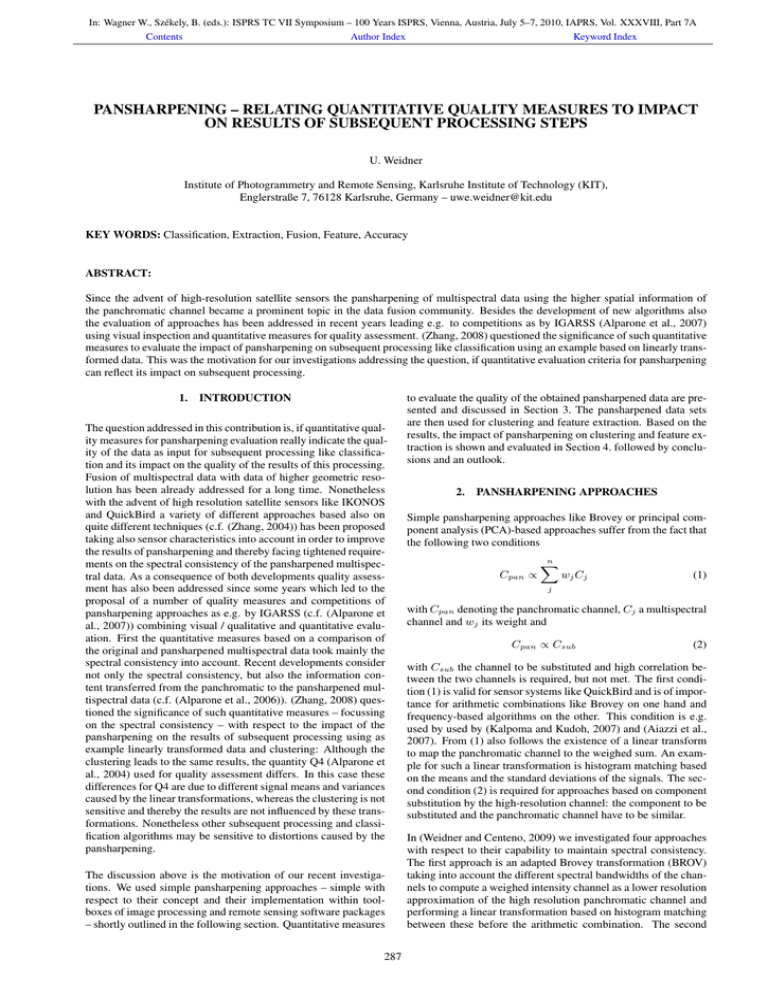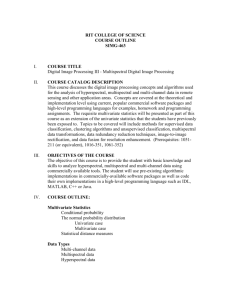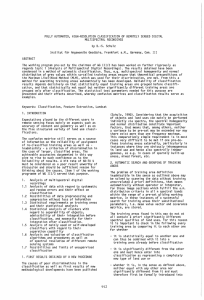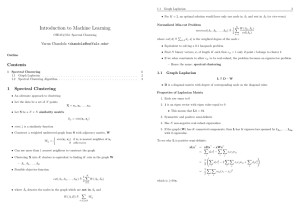PANSHARPENING – RELATING QUANTITATIVE QUALITY MEASURES TO IMPACT
advertisement

In: Wagner W., Székely, B. (eds.): ISPRS TC VII Symposium – 100 Years ISPRS, Vienna, Austria, July 5–7, 2010, IAPRS, Vol. XXXVIII, Part 7A Contents Author Index Keyword Index PANSHARPENING – RELATING QUANTITATIVE QUALITY MEASURES TO IMPACT ON RESULTS OF SUBSEQUENT PROCESSING STEPS U. Weidner Institute of Photogrammetry and Remote Sensing, Karlsruhe Institute of Technology (KIT), Englerstraße 7, 76128 Karlsruhe, Germany – uwe.weidner@kit.edu KEY WORDS: Classification, Extraction, Fusion, Feature, Accuracy ABSTRACT: Since the advent of high-resolution satellite sensors the pansharpening of multispectral data using the higher spatial information of the panchromatic channel became a prominent topic in the data fusion community. Besides the development of new algorithms also the evaluation of approaches has been addressed in recent years leading e.g. to competitions as by IGARSS (Alparone et al., 2007) using visual inspection and quantitative measures for quality assessment. (Zhang, 2008) questioned the significance of such quantitative measures to evaluate the impact of pansharpening on subsequent processing like classification using an example based on linearly transformed data. This was the motivation for our investigations addressing the question, if quantitative evaluation criteria for pansharpening can reflect its impact on subsequent processing. 1. INTRODUCTION The question addressed in this contribution is, if quantitative quality measures for pansharpening evaluation really indicate the quality of the data as input for subsequent processing like classification and its impact on the quality of the results of this processing. Fusion of multispectral data with data of higher geometric resolution has been already addressed for a long time. Nonetheless with the advent of high resolution satellite sensors like IKONOS and QuickBird a variety of different approaches based also on quite different techniques (c.f. (Zhang, 2004)) has been proposed taking also sensor characteristics into account in order to improve the results of pansharpening and thereby facing tightened requirements on the spectral consistency of the pansharpened multispectral data. As a consequence of both developments quality assessment has also been addressed since some years which led to the proposal of a number of quality measures and competitions of pansharpening approaches as e.g. by IGARSS (c.f. (Alparone et al., 2007)) combining visual / qualitative and quantitative evaluation. First the quantitative measures based on a comparison of the original and pansharpened multispectral data took mainly the spectral consistency into account. Recent developments consider not only the spectral consistency, but also the information content transferred from the panchromatic to the pansharpened multispectral data (c.f. (Alparone et al., 2006)). (Zhang, 2008) questioned the significance of such quantitative measures – focussing on the spectral consistency – with respect to the impact of the pansharpening on the results of subsequent processing using as example linearly transformed data and clustering: Although the clustering leads to the same results, the quantity Q4 (Alparone et al., 2004) used for quality assessment differs. In this case these differences for Q4 are due to different signal means and variances caused by the linear transformations, whereas the clustering is not sensitive and thereby the results are not influenced by these transformations. Nonetheless other subsequent processing and classification algorithms may be sensitive to distortions caused by the pansharpening. The discussion above is the motivation of our recent investigations. We used simple pansharpening approaches – simple with respect to their concept and their implementation within toolboxes of image processing and remote sensing software packages – shortly outlined in the following section. Quantitative measures 287 to evaluate the quality of the obtained pansharpened data are presented and discussed in Section 3. The pansharpened data sets are then used for clustering and feature extraction. Based on the results, the impact of pansharpening on clustering and feature extraction is shown and evaluated in Section 4. followed by conclusions and an outlook. 2. PANSHARPENING APPROACHES Simple pansharpening approaches like Brovey or principal component analysis (PCA)-based approaches suffer from the fact that the following two conditions Cpan ∝ n X w j Cj (1) j with Cpan denoting the panchromatic channel, Cj a multispectral channel and wj its weight and Cpan ∝ Csub (2) with Csub the channel to be substituted and high correlation between the two channels is required, but not met. The first condition (1) is valid for sensor systems like QuickBird and is of importance for arithmetic combinations like Brovey on one hand and frequency-based algorithms on the other. This condition is e.g. used by used by (Kalpoma and Kudoh, 2007) and (Aiazzi et al., 2007). From (1) also follows the existence of a linear transform to map the panchromatic channel to the weighed sum. An example for such a linear transformation is histogram matching based on the means and the standard deviations of the signals. The second condition (2) is required for approaches based on component substitution by the high-resolution channel: the component to be substituted and the panchromatic channel have to be similar. In (Weidner and Centeno, 2009) we investigated four approaches with respect to their capability to maintain spectral consistency. The first approach is an adapted Brovey transformation (BROV) taking into account the different spectral bandwidths of the channels to compute a weighed intensity channel as a lower resolution approximation of the high resolution panchromatic channel and performing a linear transformation based on histogram matching between these before the arithmetic combination. The second In: Wagner W., Székely, B. (eds.): ISPRS TC VII Symposium – 100 Years ISPRS, Vienna, Austria, July 5–7, 2010, IAPRS, Vol. XXXVIII, Part 7A Contents Author Index Keyword Index approach investigated is a PCA-based approach based on substitution. This approach was mainly included as a kind of reference in order to show the limitations of PCA-based approaches and to derive an approach based on an orthogonal transformation. The idea of this third approach (ORTHO) is to define a linear combination of the multispectral channels according to the conditions stated above for the channel to be substituted, thus defining the first row of the transformation matrix. The other rows are constructed in such a way that the rows constitute an orthogonal basis. The fourth approach is based on linear filter, namely Laplace and is thereby frequency-based (PANSHLPL). Details on the implementations of these approaches can be found in (Weidner and Centeno, 2009). 3. Figure 1: Subset URBAN - original data QUANTITATIVE EVALUATION APPROACHES (Wang and Bovik, 2002) proposed the index defined by ρW B = 4·σAB ·µA ·µB 2 2 (σA + σB )(µ2A + µ2B ) (3) ranging from 0 to 1 to measure the similarity between two one2 channel gray-valued images. µA and µB denote the means, σA 2 and σB the variances and σAB the covariance of the images. It can be rewritten to ρW B = σAB 2·µA ·µB 2·σA ·σB · 2 · 2 σA ·σB µ2A + µ2B σA + σB (4) in order to clarify the parameters. Each criterion has been used in a number of publications on pansharpening evaluation, but they are now combined. A detailed discussion of terms and how (4) can also be used within pansharpening is given in (Weidner and Centeno, 2009). In a first step (Alparone et al., 2004) generalised the index of (Wang and Bovik, 2002). This generalised index Q4 is applied in (Alparone et al., 2007) besides two other measures - SAM and ERGAS. Their generalisation is based on the use of quaternions and thereby restricted to evaluate results of images with n = 4 channels. We therefore propose to generalise the index of (Wang and Bovik, 2002) by ρ∗W B = 4·tr(ΣAB )·|µA |·|µB | (tr(ΣA ) + tr(ΣB ))(|µA |2 + |µB |2 ) (5) where tr denotes the trace of a matrix, µA the vector of mean values of data set A, |µA | the length of the vector, ΣA the covariance matrix of A, and ΣAB the covariance matrix of the data sets to be compared. Instead of the quantity Q4, (5) is not restricted to four channels. In order to overcome the restriction of dimension and to also include the information content of the pansharpened multispectral channels in the quality assessment, (Alparone et al., 2006) proposed a new index QNR which consists of two terms. The first term is based on the quality index of (Wang and Bovik, 2002) comparing the multispectral original and pansharpened data and added for all channels, the second is based on similarity measure between multispectral and panchromatic data in a high resolution and low resolution version. In our investigation we will use a different approach motivated by (Xydeas and Petrovic, 2000) to measure the information content of the pansharpened image, namely the correlation of gradient information. For this purpose first a weighed mean of the multispectral data according to (1) is computed followed by computing the gradient absolute values of the weighed mean of the multispectral channels and the panchromatic channel and their correlation ρ∗∇ leading to the quantity ∗ ∗ qT∗ = qW B ·ρ∇ Figure 2: Subset FOREST - original data (6) 288 Figure 3: Subset RIVER - original data as a combined quantity to evaluate spectral consistency and information content. We prefer this quantity, because the gradient information forms the basis for point / feature extraction and should therefore be closely related to results of these algorithms. 4. SETUP OF INVESTIGATIONS AND RESULTS Our investigations relating quantitative quality measures for pansharpening with the impact of pansharpening on subsequent processing of remote sensing data is based on a number of subsets from a QuickBird scene. Results for three subsets are discussed in more detail. These subsets constitute of an urban area (URBAN, Fig. 1), a mixed area with a sewage plant and forest (FOREST, Fig. 2) and an area with a larger river bed (RIVER, Fig. 3). The first subset provides a variety of different surface covers including man-made structures. The other subsets are selected for their simplicity on one hand, but also for their spectral properties – namely the homogeneous forest and water areas – on the other hand. In: Wagner W., Székely, B. (eds.): ISPRS TC VII Symposium – 100 Years ISPRS, Vienna, Austria, July 5–7, 2010, IAPRS, Vol. XXXVIII, Part 7A Contents Author Index Keyword Index Multispectral Panchromatic BROV PCA ORTHO PANSHLPL Figure 5: Results for subset URBAN (section) Multispectral Panchromatic BROV PCA ORTHO PANSHLPL Figure 6: Results for subset RIVER (section) Table 4: Evaluation by quantitative measure 289 In: Wagner W., Székely, B. (eds.): ISPRS TC VII Symposium – 100 Years ISPRS, Vienna, Austria, July 5–7, 2010, IAPRS, Vol. XXXVIII, Part 7A Contents Author Index Keyword Index Table 7: Comparison of clustering results URBAN Tab. 4 compiles the quantitative indicators discussed in the previous section in sequence of the three subsets and the algorithms described in Section 2.. The results are given for the four single multispectral layers (B, G, R, NIR) numbered from 1 to 4 according to (3), the mean value of these results and the combination of the four channels using (5). The next column compiles the correlation of corresponding Soobel gradient images and the last column the results for qT∗ according to (6). In this contribution the quantities are computed for the entire subsets. A distinction between homogeneous and non-homogeneous areas (edges) is made in (Weidner and Centeno, 2009). The ranking of algorithms keeps the same, but results are worse within edge regions. Fig. 5 displays the original data and the results for a smaller section – using a clipping of 5 % of each channels histogram – of the subset URBAN. The quantities involved in (6) show only minor differences except PCA. For all algorithms the result for the first channel (B) is minor to the other channels. A closer analysis further indicates that those algorithms mainting spectral properties are minor in transferring the gradient information to the pansharpened multispectral channels. This trade-off is not surprising especially for simple algorithms as used here. Furthermore, those algorithms performing a linear transformation work slightly better than others taking the correlation of gradient information into account. Nonetheless, the quantities indicate problems with the PCA-based algorithm, which also could be verified by visual inspection. In fact the PCA-based algorithm turns out to perform worst (c.f. Fig. 6) also for the two other selected subsets due to their special characteristics and the data dependence of PCA determining the transformation matrix. The difficulties for single channels are disguised by the criterion based on the set of all channels. The SAM criterion indicates that the fourth algorithm based on linear filtering has no impact on SAM independent from the data. In the following we address the impact of pansharpening on two possible processing steps, namely classification and point extraction. We selected these two processing steps, because classification depends on the spectral properties and point extraction on the information content given by the gradient information. For unsupervised classification we selected k-means clustering and 8 clusters for all subsets although the complexity of the subsets is different. The clustering results for the different pansharping results are not identical concerning their ID and therefore clusters are automatically assigned using the overall accuracy as criterion. Clustering adopts for linear changes in feature space and therefore linear spectral transformations do not have an influence on its result. For the comparison of the clustering results using the pansharpened data of the first data set URBAN Tab. 7 compiles the overall accuracies and the κ indices. The clustering is performed on the entire data set, but for the analysis three cases a discerned: entire data set, homogeneous and non-homogeneous areas as in (Weidner and Centeno, 2009) for the quality measures applied therein. Within the homogeneous areas the results 290 Figure 8: Subset URBAN clustering - BROV homogeneous areas Table 9: Comparison of clustering results FOREST / RIVER (homogeneous areas) of clustering should not differ, for edge regions differences have to be expected. As an example the result of clustering based on the pansharpened data by BROV within the homogeneous areas is shown in Fig. 8. Although the overall visual impression for the clustering results is almost the same, smaller deviations can be observed which also lead to a lower overall accuracy taking the clustering result of the original multispectral data as reference. The ranking is the same for all three cases mentioned above taking the significance of differences between the overall accuracies into account. Again the result for the edge regions are minor to those of the homogeneous regions. The results for the first data set are confirmed by the results of the subset FOREST (c.f. Tab. 9). In case of the subset RIVER however the ranking according the overall accuracy differs significantly. The visual comparison of the data (c.f. Fig. 6 and Fig. 10 for the results of clustering) is in accordance with the quality evaluation taking the single channels as basis, but is not apparent neither by ρ∗W B nor the overall accuracy. The value and / or range of overall accuracies depend on the data and the class distribution. The data set was selected to study homogeneous regions (dominant cluster river) and their impact on the preprocessing for pansharpening. Therefore not the absolute values but only the rankings are of interest. For the subset RIVER a test of the impact of pansharpening on Maximum-Likelihood (ML) classification is accomplished. Compared to the other data sets it comprises only few classes. Four training areas for the river (Rhine), fields (bare soil), meadows and forest – the most dominant classes – are defined in homogeneous areas. The first set of classifications used the spectral signatures from the original multispectral data serving as spectral library, the second set the spectral signatures from each data set. Therefore the results of the first set are affected by linear changes, but not those of the second set. All other parameter settings are kept the same. Results are displayed in Fig. 11 showing only a small section for better visualisation and statistics for the entire subsets (homogeneous areas) are given Tab. 12. Except for PCA the achieved overall accuracies are in the same range for both settings. The deviations for PCA are caused by the spectral distortions (c.f. Tab. 4) and are anticipated (c.f. Tab. 13 for the In: Wagner W., Székely, B. (eds.): ISPRS TC VII Symposium – 100 Years ISPRS, Vienna, Austria, July 5–7, 2010, IAPRS, Vol. XXXVIII, Part 7A Contents Author Index Keyword Index Multispectral Multispectral Spectral signatures from original MS data BROV ORTHO PCA BROV PCA ORTHO PANSHLPL PANSHLPL Figure 10: Clustering results for subset RIVER (section) Bhattacharrya distances between the original spectral data and those of the pansharpened for each training area). In order to evaluate the impact of pansharpening algorithms on point extraction the SIFT operator (Lowe, 2004) is selected including also a matching of points across the data sets. The evaluation is based on the pansharpened multispectral data for which a weighed mean according to (1) is computed. Point extraction uses the panchromatic channel as reference and only those points which are matched across all pansharpening results for a data set are included in the analysis. The statistics in Tab. 14 are based on about 260 points for the subset URBAN, 280 points for the subset FOREST and 140 points for the subset RIVER. These points are evenly distributed across the data sets except for the river which also caused the lower number of matched points. Given are the Table 12: Comparison ML-classification (homogeneous areas) Spectral signatures from each data set BROV PCA ORTHO PANSHLPL Figure 11: ML-classification results for subset RIVER (section) Table 13: Bhattacharrya distances 291 In: Wagner W., Székely, B. (eds.): ISPRS TC VII Symposium – 100 Years ISPRS, Vienna, Austria, July 5–7, 2010, IAPRS, Vol. XXXVIII, Part 7A Contents Author Index Keyword Index bination of different criteria. Therefore, just one index seems to be inappropriate. In addition specialised criteria with respect to input data and processing steps should also be used like SAM for hyperspectral data (Klonus and Ehlers, 2009). The results of our investigations are based on a number of subsets. Therefore tests will be performed on further data sets in order to form a wider basis. Furthermore the impact on segmentation will be addressed based on (Weidner, 2008). REFERENCES Aiazzi, B., Baronti, S. and Selva, M., 2007. Improving component substitution pansharpening through multivariate regression of MS+pan data. IEEE Transactions on Geoscience and Remote Sensing 45(10), pp. 3230 – 3239. Table 14: Results of point matching (SIFT) [pixel] mean point distances, their standard deviation and their median for comparison. A low mean and median of point distances indicate that the matched point of the pansharpened data are close to the original positions derived from the high resolution panchromatic channel. If furthermore the standard deviation of the point distances is low, most point positions are in agreement. The correlations of the Sobel gradients given in Tab. 4 are almost in the same range for all algorithms and data sets. For comparison the original multispectral data is also included in Tab. 14. The correlations for these unsharpened data sets are about 0.4 and therefore the high values for the point deviations for the unsharpened data sets and those of BROV and ORTHO are in agreement, but not those of PCA and PANSHLPL. For the PANSHLPL result the reason may be found in effects due to the unsharp masking leading to visual sharp, but deteriorated edge information. The PCA and ORTHO algorithms are similar in the sense that they both perform a linear transformation, nevertheless the spectral distortions produced by the PCA algorithms cause problems within matching and finally in the point positions. These results with respect to its ranking are confirmed by recent preliminary results of point extraction based on manual measurement and least squares matching for point transfer. 5. CONCLUSIONS Pansharpening and its evaluation using quantitative measures are addressed by a large number of publications. Motivated by (Zhang, 2008) this contribution investigates to which extend such quality measures reflect the impact of pansharpening on subsequent processing steps in remote sensing. For this purpose simple pansharpening approaches are applied to QuickBird data. As examples for processing classification and point extraction are investigated. The quality measures used here evaluate mostly linear spectral distortion and the degree of information transformation from the high resolution panchromatic channel to the multispectral channels, namely the gradient. Partly subsequent processing steps are insensitive to linear transformations like clustering at least within homogeneous regions. Nevertheless, problems occur at edges. Therefore homogeneous and non-homogeneous regions should be evaluated separately (c.f. (Perko, 2004) and (Weidner and Centeno, 2009)). In most cases it could be demonstrated that the quality indices for pansharpening evaluation are in agreement with the quality of the processing results based on the pansharpened data, but also cases are discussed where the quality measures for the pansharpening results do not significantly differ, but the results of the processing. The reason for this is the fact that processing steps are influenced by effects of pansharpening which can not entirely evaluated by a single quantity – although a com292 Alparone, L., Aiazzi, B., Baronti, S., Garzelli, A. and Nencini, F., 2006. Information-theoretic image fusion assessment without reference. In: ESA-EUSC 2006: Image Information Mining for Security and Intelligence. Alparone, L., Baronti, S., Garzelli, A. and Nencini, F., 2004. A global quality measurement of pan-sharpened multispectral imagery. IEEE Geoscience and Remote Sensing Letters 1(4), pp. 313 – 317. Alparone, L., Wald, L., Chanussot, J., Thomas, C., Gamba, P. and Bruce, L., 2007. Comparison of pansharpening algorithms: Outcome of the 2006 GRS-S data-fusion contest. IEEE Transactions on Geoscience and Remote Sensing 45(10), pp. 3012 – 3021. Kalpoma, K. and Kudoh, J.-I., 2007. Image fusion processing for IKONOS 1-m color imagery. IEEE Transactions on Geoscience and Remote Sensing 45(10), pp. 3075 – 3086. Klonus, S. and Ehlers, M., 2009. Auswirkungen der Bildfusion auf Hyperspektraldaten. In: 29. Wissenschaftlich-Technische Jahrestagung der DGPF 2009, Jena, pp. 277 – 286. Lowe, D., 2004. Distinctive image features from scale-invariant keypoints. International Journal of Computer Vision 60, pp. 91 – 110. Perko, R., 2004. Computer Vision for Large Format Digital Aerial Cameras. PhD thesis, Institute for Computer Graphics and Vision, Graz University of Technology. Wang, Z. and Bovik, A., 2002. A universal image quality index. IEEE Signal Processing Letters 9(3), pp. 81 – 84. Weidner, U., 2008. Contribution to the assessment of segmentation quality for remote sensing applications. In: IAPRSIS, Vol. 37, Part B7, pp. 1101 – 1110. Weidner, U. and Centeno, J., 2009. Pansharpening – simple approaches and their evaluation. Photogrammetrie - Fernerkundung - Geoinformation PFG 4, pp. 317 – 327. Xydeas, C. and Petrovic, V., 2000. Objective image fusion performance measure. Electronic Letters 36(4), pp. 308 – 309. Zhang, Y., 2004. Understanding image fusion. Photogrammetric Engineering & Remote Sensing 70(6), pp. 657 – 661. Zhang, Y., 2008. Methods for image fusion quality assessment - a review, comparison and analysis. In: IAPRSIS, Vol. 37, Part B7, pp. 1101 – 1110.





